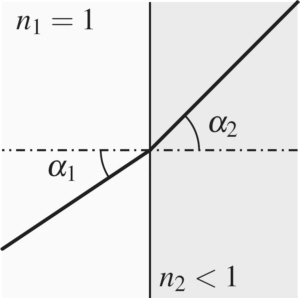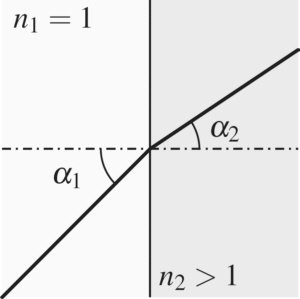Los rayos X se refractan al pasar por zonas con densidad óptica variable. En la mayoría de los casos, esto ocurre al pasar por una superficie límite entre gas o vacío y materia sólida o líquida.
La refracción se describe mediante el índice de refracción complejo n*:

siendo n la parte real y β la parte imaginaria (valores β y n listados, por ejemplo) del índice de refracción complejo n*. En el caso de los rayos X, suele escribirse como

con

y el decremento δ. Esta notación es útil ya que para los rayos X los valores de δ son positivos y muy pequeños (por ejemplo, en el rango de 10-4 to 10-6, ver fig. 1).

Fig. 1: Decremento δ del índice de refracción n para algunos polímeros típicamente utilizados como material para lentes refractivas de rayos X.
Como n es menor que uno para los rayos X en cualquier materia, los rayos X procedentes, por ejemplo, del aire o del vacío y que penetran en sólidos o líquidos se refractan alejándose de la normal de la superficie de refracción (Fig. 2). En el caso de la luz visible, los rayos se refractan hacia la normal de la superficie refractante. Una consecuencia de este hecho es que las lentes refractivas de enfoque para rayos X tienen que tener la forma de lentes dispersoras para luz visible, es decir, tienen que ser más delgadas en el centro que en su borde (véase CRL).
 |
 |
|
| Refracción de rayos X | Refracción VIS |
Fig. 2: Los ángulos de refracción se calculan con la ley de Snell (también llamada «ley de Snellius», «ley de Descartes» o «ley de la refracción»):
Dirección de la luz refractada para los rayos X (imagen de la izquierda) que entran desde el vacío (blanco) en un sólido o líquido (gris) y la luz visible (imagen de la derecha); para los rayos X el ángulo α2 es casi el mismo que α1 : para mayor claridad, se ha exagerado mucho.
Los ángulos de refracción se calculan con la ley de Snell (también llamada «ley de Snellius», «ley de Descartes» o «ley de la refracción»):

con los ángulos de incidencia αi y la velocidad de la luz vi en la materia con el índice de refracción ni . El índice de refracción ni es la velocidad de la luz en el vacío c0 dividida por la velocidad de la luz vi en la materia:

Como la disminución δ del índice de refracción es pequeña, los ángulos de refracción resultantes son también muy pequeños.
Desfase de los rayos X al atravesar la materia
Cuando los rayos X atraviesan un bloque de longitud L1 hecho de materia con índice de refracción n = 1 - d (marcado en azul en la Fig. 3), el decremento del índice de refracción d, el frente de onda se desplaza en relación con un frente de onda que atraviesa el vacío d = 0 (o aproximadamente el aire). La onda en la materia precede a la onda en el vacío, ya que el índice de refracción en la materia es menor que uno. El desplazamiento D es
D = L1 - L0
con las velocidades de la luz c0 en el vacío y c1 en la materia y el tiempo de tránsito t se convierten en
L0 = c0 * t y L1 = c1 * t
⇔ L0 = L1* n = L1 - D
⇔ D = L1* d
¿Qué magnitud debe tener L1 para que una energía fotónica de, por ejemplo, 12,4 keV (l = 0,1 nm) produzca un desfase de l/2 en el polímero SU-8 (con el que también se fabrican lentes refractivas de rayos X)? El valor l/2 es importante porque es el valor más pequeño que conduce a una interferencia destructiva de las dos ondas. La decremento del índice de refracción es dSU-8(12,4 keV) = 1,82*10-6. Esto da como resultado L1 = 27,5 µm. Se trata de un valor grande teniendo en cuenta el pequeño desplazamiento de fase de sólo 0,05 nm. Esto significa, por ejemplo, que el desnivel en las superficies de una lente refractiva de rayos X puede ser significativamente mayor que con una lente para luz visible, donde un desnivel de sólo ≈0,5 µm conduce a un desfase de lVIS/2 en comparación con una onda de luz en el vacío.

Fig. 3: Desfase de los rayos X que atraviesan el vacío (abajo) y la materia (azul, arriba)


